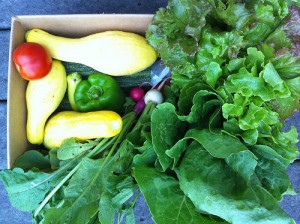Dietary Fibre consists of naturally occurring plant materials that your body cannot digest. Examples include fibre naturally found in whole grain breads and cereals, beans, lentils, fruits and vegetables.
As fibre is a vital part of one’s diet, and eating local produce is good for your community and the environment, right now there are many reasons to eat fruits and vegetables that are in-season in BC to help you increase the amount of fibre in your diet every day!
In-season produce for BC in July:
Apricots, Beets, Blueberries, Broccoli, Cabbage, Carrots, Celery, Cherries, Kale, Lettuce, Peas, Peppers, Potatoes, Raspberries, Spinach, Strawberries, Squash, Chard, Tomatoes, Chives, Cilantro, Cucumbers (see the link at the end to find out more).
What are the health benefits?
1- Bowel regularity
2- Control of blood cholesterol
3- Control of blood sugar levels.
Fibre can be found on their own or added to foods. Examples include oat B-glucan, psyllium.
Fibre is linked with reducing the risk of heart disease, diabetes, obesity and certain types of cancer.
What else does it do?… High fibre diets provide bulk, make you feel fuller for longer, which is why people who have high fibre diets tend to have lower body weights (many businesses have been taking advantage of this recently (for example, PGX).
Fibre can be further divided into those that are soluble and those that are insoluble (interestingly, experts now wish to replace these terms with “viscosity” and “fermentality”).
Soluble fibres -found in foods such as oat bran, psyllium, legumes, vegetables barley and certain types of fruits. -These reduce blood cholesterol levels and control blood sugar levels.
Monday interesting health fact: Do you notice how oats and barley form a “sticky and gummy” texture when they are cooked? This “stickiness” is referred to as viscosity and experts believe this is what gives these fibres special health benefits (such as reducing cholesterol)!
Fermentability = digestion of soluble fibre by “friendly” bacteria in our intestines which is also important for promoting health
Insoluble fibres, such as those found in wheat bran, corn bran, flax seeds, and some vegetables and fruit (especially the skins), passes through your digestive system largely unchanged (AKA= roughage and bulk!)
Q: How should you increase your fibre intake?
A: Gradually, and drink lots of fluids. Most foods contain a mix of fibres, so make sure you choose a variety of fibre-rich choices from the different food groups to reach your target. This way you can reap the benefits from all types of fibres.
Q: What exactly is a high fibre food?
A: A high fibre food contains 5 or more grams of fibre per serving!
Click here for more useful pointers from the Dietitians of Canada to help you reach your goal of 38 grams for men and 25 grams for women of fibre each day.
Click here for more of in-season BC produce for July and beyond!
Click here to listen to our podcast (scroll forward to approximately 1/3 way through the news cast)

